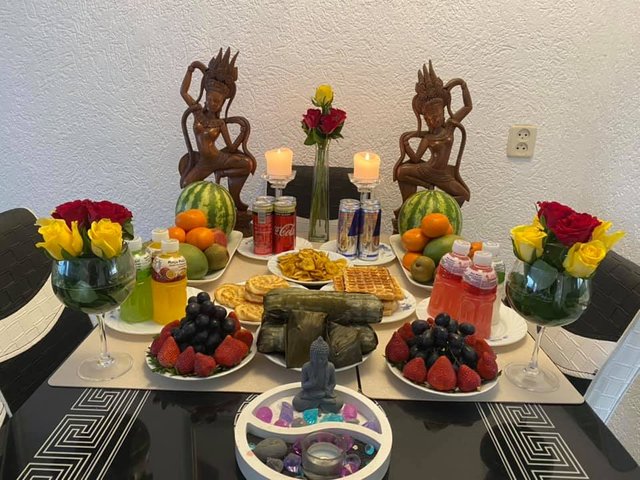Happy Khmer/Thai/Lao/Burmese New Year!
🌸🌸🌸 𝗛𝗮𝗽𝗽𝘆 𝗖𝗮𝗺𝗯𝗼𝗱𝗶𝗮𝗻 𝗡𝗲𝘄 𝗬𝗲𝗮𝗿𝘀 𝗲𝘃𝗲𝗿𝘆𝗼𝗻𝗲 ! 🌸🌸🌸 សួស្តីឆ្នាំថ្មីប្រពៃណីខ្មែរ🇰🇭
This year, this is the Goddess Moaha Reach Devi will arrive, (មហោរះទេវី) she is the last of the seven daughters of the god Brahma.
She will happen on The 14th of April at 4:am time from Cambodia .
The 13th of April at 11:00 p.m. Netherlands time.
And the 13th of April at 2:00 p.m. in the American time.
Khmer New Year Celebration is recognized as the most significant festival and national holiday in Cambodia.
It is the time of the year when Cambodian families get together to celebrate the occasion especially at their hometown. During the celebration, pagoda areas and public street corners are packed with groups of children and adults relishing Khmer traditional games and dancing.
Generally, Khmer New Year falls on either the 13th or 14th of April depending on the dictate of Khmer ancient horoscope reading and is usually held for 3 consecutive days. Khmer New Year marks the end of the harvest before the beginning of the rainy season. Like most Cambodian celebration; the New Year festival is full of tradition and rituals. Each day of the celebration has its distinctive name along with associated traditions.
Day 1 “𝗠𝗮𝗵𝗮 𝗦𝗮𝗻𝗸𝗿𝗮𝗻𝘁𝗮”
The first day of Khmer New Year is called “Maha Sankranta”. It can simply be described as an inauguration of New Year. In Khmer tradition, the world is believed to be created by God and taken care of by his Devas. On the day, family members work hard on cleaning and decorating the house and help arranging foods and drinks on a table as to welcome the new Devi. Buddhist followers may also prepare food and fruits to be offered to the monks for blessings.
Day 2 “𝗩𝗶𝗿𝗮𝗸 𝗩𝗮𝗻𝗮𝗯𝗮𝘁”
The second day of the celebration is called “Virak Vanabat”. It signifies a day of offering gifts to the elders includes parents and grandparents. Most Cambodian offer charity by donating food, money or clothes to the less fortunate. In the evening, the young and elder would go to religious temples to perform the ceremony of erecting sandy mounds on the temple ground. The ritual is believed to bring Cambodian people longevity and prosperity in life.
Day 3 “𝗩𝗲𝗮𝗿𝗮𝗸 𝗟𝗲𝘂𝗻𝗴 𝗦𝗮𝗸”
The third day or the final day of new year celebration is called "Vearak Leung Sak". It is the day when the year of 2020, for example, would change and begin to be 2021 customarily, to complete the New Year festival; Cambodians need to perform the last ceremony called "Pithi Srang Preah". The ritual is done by washing and cleaning the statues of Lord Buddha with scented water. This is meant to symbolize the washing away of evil deeds and gaining blessings.
This tradition can refer to Hinduism of Angkor period, to which the goddess ganga (Mekong) is to wash the sins and evil karma of peoples.
The incense was also intended to cover the Shiva linga.
The elders whom you respect such as parents and grandparents can also be washed the same way as to apologize them for past mistakes and to gratify them.
𝗕𝘂𝘁 𝘂𝗻𝗳𝗼𝗿𝘁𝘂𝗻𝗮𝘁𝗲𝗹𝘆, 𝗱𝗲𝘀𝗽𝗶𝘁𝗲 𝘁𝗵𝗲 𝗖𝗼𝘃𝗶𝗱 𝗪𝗼𝗿𝗹𝗱 𝗘𝗽𝗶𝗱𝗲𝗺𝗶𝗰 𝟭𝟵, 𝘁𝗵𝗲 𝗖𝗮𝗺𝗯𝗼𝗱𝗶𝗮𝗻 𝗴𝗼𝘃𝗲𝗿𝗻𝗺𝗲𝗻𝘁 𝗱𝗲𝗰𝗶𝗱𝗲𝗱 𝘁𝗼 𝗰𝗮𝗻𝗰𝗲𝗹 𝘁𝗵𝗲 𝗰𝗹𝘂𝘀𝘁𝗲𝗿𝘀 𝗳𝗼𝗿 𝘁𝗵𝗲 𝗳𝗲𝘀𝘁𝗶𝘃𝗶𝘁𝗶𝗲𝘀. 𝗦𝗼 𝗜 𝘄𝗶𝘀𝗵 𝘆𝗼𝘂 𝗮𝗹𝗹 𝗮𝗻𝗱 𝗮𝗹𝗹 𝗼𝗳 𝘂𝘀 𝘁𝗼 𝘁𝗮𝗸𝗲 𝗰𝗮𝗿𝗲 𝗼𝗳 𝗮𝗹𝗹 𝗼𝗳 𝘆𝗼𝘂!
𝗔𝗻𝗱 𝘁𝗼 𝗿𝗲𝘁𝘂𝗿𝗻 𝘁𝗼 𝘁𝗵𝗲 𝗲𝘀𝘀𝗲𝗻𝘁𝗶𝗮𝗹 𝗮𝗻𝗱 𝗺𝗲𝗮𝗻𝗶𝗻𝗴 𝗼𝗳 𝘁𝗵𝗶𝘀 𝘁𝗿𝗮𝗱𝗶𝘁𝗶𝗼𝗻. 𝗠𝗮𝘆 𝗮𝗹𝗹 𝘁𝗵𝗲 𝗚𝗼𝗱𝘀 (នាគរាជ & ទេវី) 𝗯𝗹𝗲𝘀𝘀 𝘆𝗼𝘂!
At my sister home

At home
